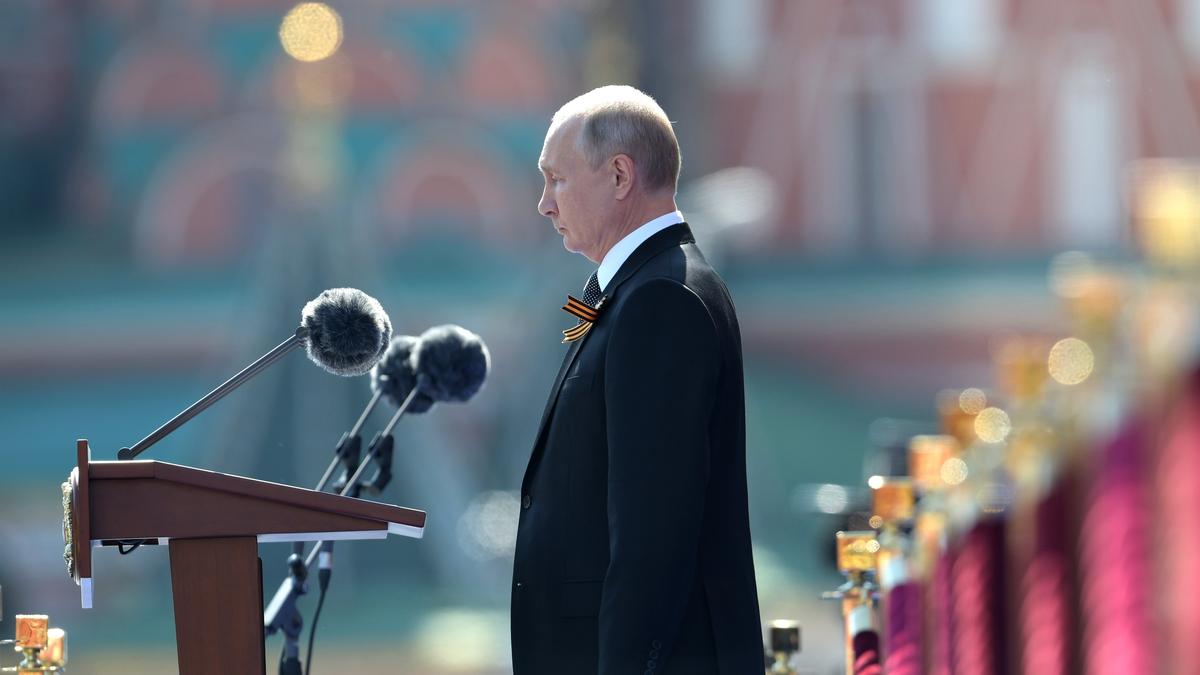Most Russians still consider Victory Day, when the country celebrates the Soviet victory over Nazi Germany on 9 May, to be the most important holiday of the year. From its first celebration in modern Russia, the Russian leadership has seen it as an opportunity to praise the Soviet past for its own political gain. For Vladimir Putin, invading Ukraine was tantamount to reliving the Great Patriotic War — the term used in Russia to describe the Soviet role in World War II — all over again, a war that continues to serve a propaganda role decades after its conclusion.
Victory Day was first celebrated in the Soviet Union to mark the 20th anniversary of the German defeat in 1965. What had until then been just another workday became a public holiday which, as Russian historian Kirill Kobrin argues, was used from the outset as a political tool, with Soviet leader Leonid Brezhnev keen to use the event as a means of boosting the USSR’s image internationally.
While cultural historian Alexander Markov has noted how evident the tastes of the Brezhnev-era elite continue to be today in the aesthetic and rituals created for the holiday during that era, he also points out Victory Day’s elasticity, which makes it a celebration that can be easily reinvented and repurposed to meet the needs of the government of the day.
The first Victory Day to be celebrated in post-Soviet Russia was held on the 50th anniversary of the German capitulation in 1995, at a time when presidential incumbent Boris Yeltsin appeared to be on the verge of losing power to his communist opponent Gennady Zyuganov. In a shrewd and shameless move, Yeltsin decided to end the monopoly on Soviet nostalgia claimed by his rival by bringing back and embracing the holiday.
Finding a remedy (2000-2004)
Several more parades were held under Yeltsin the late 1990s, but they were far more modest affairs that attracted dwindling levels of attention. It took Vladimir Putin’s appointment as president in 2000 to change that, something he did to solve Russia’s chronic post-Soviet identity crisis.
Putin was painfully aware that the overnight vanishing of the Soviet Union had taken with it a national identity formed through 70 years of ceaseless messaging and propaganda. In 1999, he wrote of the atomisation of post-Soviet society and lamented its division into different groups, which, he argued, stood in the way of Russia regaining its status of a great power. It was a challenge he got to work solving as soon as he became president the following year.

Tanks drive past Moscow’s Triumphal Arch on the 50th anniversary of the victory over Nazi Germany, 9 May 1995. Photo: EPA / ALEXEY DITYAKIN
One of Putin’s priorities in his first presidential term was the construction of a new national identity for Russians to coalesce around following a decade of post-Soviet turmoil, something that can clearly be seen in his Victory Day speeches during those years in which he assured the millions of viewers that they were heirs to an extraordinary military legacy.
From the start of his rule, Putin was at pains to stress that those who served in the modern Russian military were the heirs to the Red Army.
In addition to changing Russia’s anthem to a Soviet-style one, Putin proudly reinstated the use of several Soviet symbols such as the red banner to the Victory Day parades, which had not been used in Yeltsin’s new Russia. “In our times — as in the years of the war — the red flag of the armed forces is back in use,” Putin proudly declared in 2001. From the start of his rule, Putin was at pains to stress that those who served in the modern Russian military were the heirs to the Red Army, and in 2001 described the Soviet victory in World War II as “the spiritual bedrock of the Russian Army”.
However, Putin also made clear that the Soviet victory over Nazi Germany was not something owned exclusively by Russian soldiers, and that every Russian was also its heir, a rhetorical manoeuvre designed to imply the state’s expectation that every member of the population will also feel duty bound to serve the motherland if called to. The Russian victory in World War II was “our wealth and spiritual beacon”, Putin said in 2003, adding that keeping that sacred memory and working hard for the country’s betterment were the duties of all Russians.
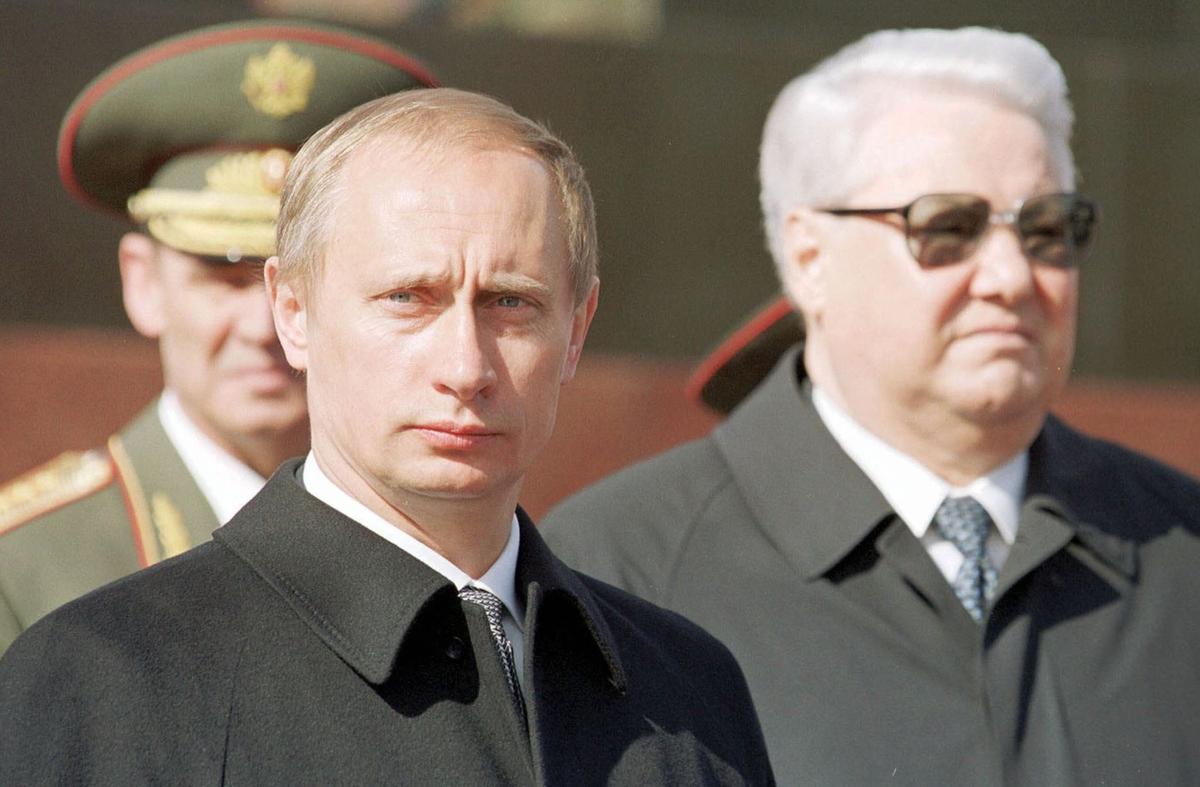
Russian President Vladimir Putin and former president Boris Yeltsin (R) watch the Victory Day military parade on Red Square, 9 May, 2000. Photo: EPA.
During this era, Putin would exhort Russians to imitate the example set by their forebears during the war, when they performed heroic feats in the face of adversity, telling them in 2003 that the Soviet victory should inspire Russians to perform “new deeds” and to “reach victorious new heights,” presenting World War II as the foundation upon which contemporary Russian identity could be built.
Politics played a fairly minor role in Putin’s Victory Day speeches during his first term, though they nevertheless served to reflect the country’s political climate at the time. During this era Putin compared the contemporary threat posed to Russia by terrorism to the Nazi threat of the past, and by doing so, implicitly equated himself with Joseph Stalin, something that served his political agenda while also boosting his approval ratings.
The holiday was also used as a means of promoting modern Russia’s ties with its “near abroad”, the commonly used term for Russia-aligned former Soviet states, of whom in 2000 Putin said that the “gunpowder of victory and the joy of victory is one for all of us.”
Putin assured parade viewers that Russia’s history of winning wars would “raise high the Russian banner of democracy and freedom”, and serve as a warning “to those who see terror and violence as their main weapons.” These comments have not aged well.
Sowing the seeds (2004-2008)
Putin’s Victory Day speeches during his second term introduced the future staples of his rhetoric, and took on characteristics that are far more recognisably Putinist to a contemporary audience.
Taking full advantage of having a captive audience of world leaders present on Red Square to mark the 60th anniversary of World War II ending in 2005, Putin pitched his speech that year very much to them. Framing Russia as a friendly country that was open to cooperation with the rest of the international community, Putin said that Russia was “ready to build such relations, which are not only cemented in the lessons of the past, but which are also aimed at our collective future.”
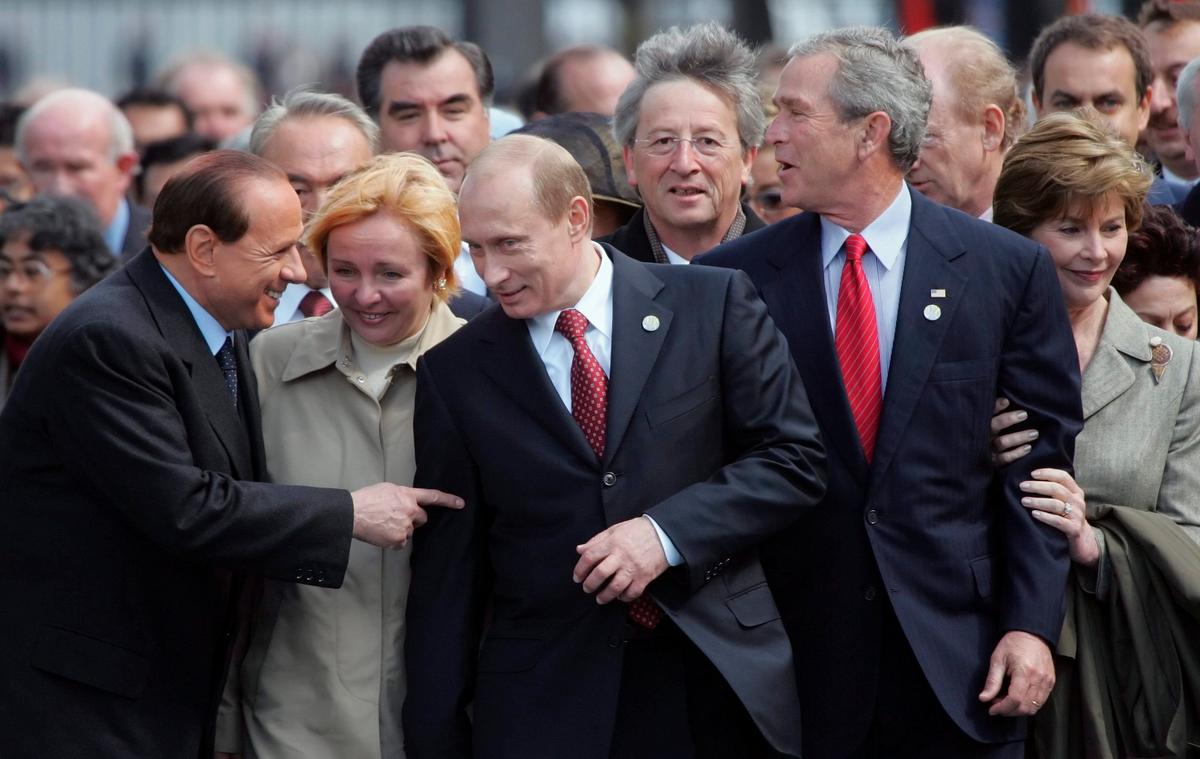
From left: Italian Prime Minister Silvio Berlusconi, Lyudmila Putina, Vladimir Putin, US President George W. Bush and his wife Laura attend the 60th anniversary of the end of World War II, 9 May 2005, Photo: EPA / ANATOLY MALTSEV
Foreign affairs became a regular and prominent part of the Victory Day speeches during his second term, and Putin would regularly call for international cooperation and unity in the face of the terrorist threat and would use his speech to lay out Russia’s foreign policy to domestic audiences.
Whereas beforehand Putin had spoken chiefly of the threat of terrorism, which he compared to Nazism, now he assured his audience that “the Nazi swastika and the ideas of fascism still traverse the world.”
In his 2005 speech, for instance, Putin assured the world that Russian foreign policy was based “on the ideals of freedom and democracy, on the right of each state to choose its own path of development,” the sole occasion on which he used such terminology in his Victory Day speeches, and which now reads as early Putin criticising his future self.
That such lofty claims could so easily be inserted into a Victory Day speech to burnish the image of Russia and its president in front of gathered world leaders further highlights the elastic nature of the holiday: democracy, national identity and terrorism are equally valid subject matter for the speech as long as a loose connection to the war can be made.
The Victory Day speeches of this term grew increasingly political and soon introduced a new propaganda narrative that would go on to be key: the ever-present threat posed by Nazism. Whereas beforehand Putin had spoken chiefly of the threat of terrorism, which he compared to Nazism, now he assured his audience that “the Nazi swastika and the ideas of fascism still traverse the world.” Fear mongering serves to rally Russians around the government, effectively utilising historical memory for political purposes.
In addition to Nazism rising from the grave, Putin identified another grave threat: those who rewrite history. In 2007 he declared that there were people trying to desecrate memorials to the heroes of war, sow enmity and “belittle the invaluable experience” of the Great Patriotic War — a direct reference to contemporaneous events in neighbouring Estonia that led to the country’s so-called Bronze Night that spring.
In April 2007, the Estonian government’s decision to relocate a Soviet war memorial from the centre of the capital Tallinn provoked civil unrest and rioting among Estonia’s ethnic Russian population. The Russian government was involved in supporting the unrest and also ordered cyberattacks on Estonian infrastructure in an attempt to topple the country’s pro-Western government.
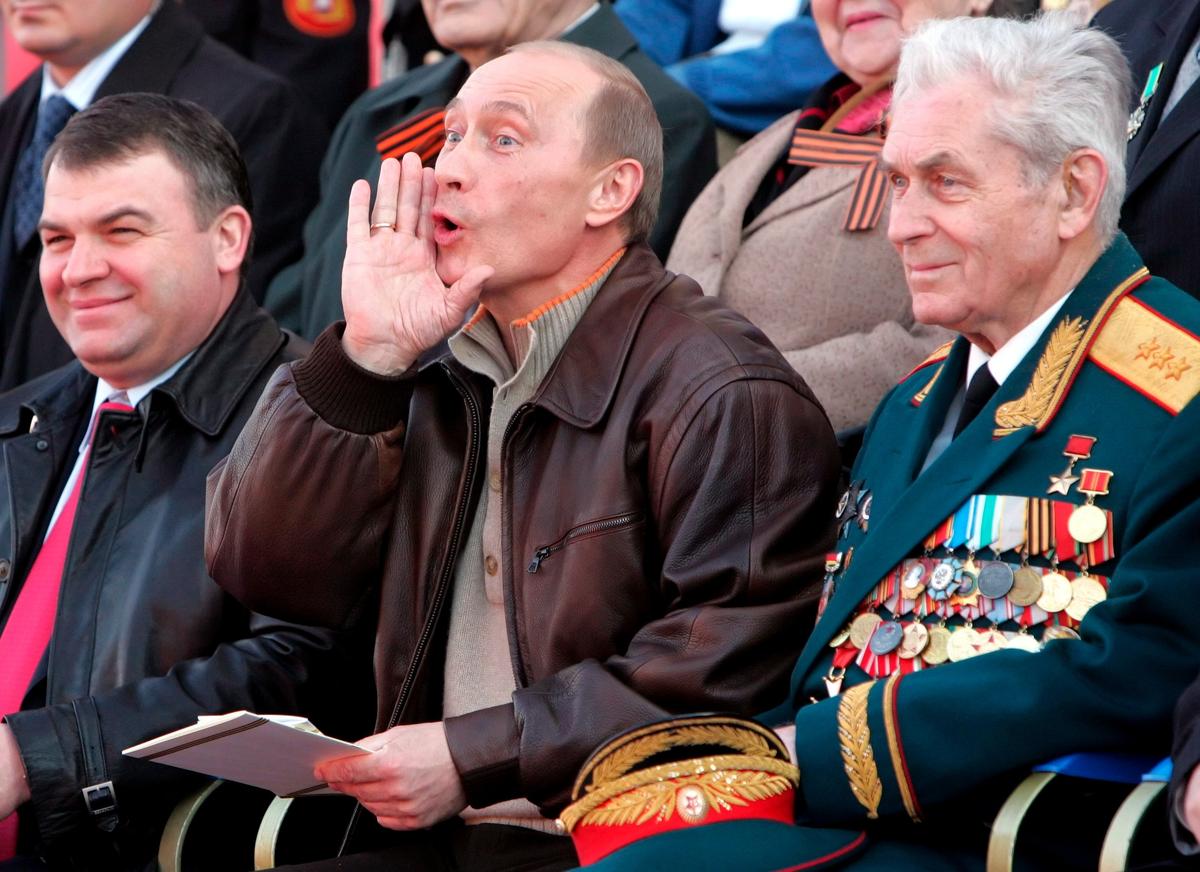
Putin greets participants in Moscow’s Victory Day celebrations on Red Square, 9 May 2007. Photo: EPA / SERGEI CHIRIKOV
These “neo-Nazis” and “historical revisionists” would go on to become some of the main bogeymen of Russian propaganda in years to follow. Victory Day’s growing role as a tool for political and militaristic mobilisation had already become clear in the early 2000s. In the last speech of this term, Putin declared that “we will selflessly defend the Motherland’s interests, just as they did”, having all Russians in mind when saying “we” and the war veterans when saying “they”.
Thunder on the horizon (2012-2018)
Putin’s Victory Day speeches grew more political upon his return to the presidency in 2012 after he and Prime Minister Dmitry Medvedev swapped seats for five years in 2008 to sidestep a constitutional ban on a president serving more than two consecutive terms.
Putin used his first Victory Day speech after his third inauguration in 2012 to signal his neo-imperialist ambitions that would see Russia’s borders expand to match those of the USSR, or at the very least have every former Soviet republic under his effective control. Giving a hint of what was to come, Putin argued that Russia had “a moral right” to pursue its aggressive foreign policy given its critical role in World War II.
While in the same speech Putin went on to state his belief in every nation’s right to self-determination, and respect for international law and state sovereignty, these seemed more like boilerplate statements, with his earlier reference to Russia having earned its moral right to do what it wanted having a far greater ring of truth to it.
The speeches maintained a mobilising tone, exhorting Russians to carry out great deeds for the motherland in imitation of their Soviet ancestors.
By 2013, Putin reasoned that as Russians remembered the tragedy of World War II so clearly, the country would “do everything in its power to ensure nobody would ever dare start one again, or threaten our children, our home, our land,” thereby affirming his readiness to do anything to anybody he perceived as a threat.
The speeches maintained a mobilising tone, exhorting Russians to carry out great deeds for the motherland in imitation of their Soviet ancestors, and Putin did not mince his words when praising the importance of Victory Day as a cornerstone of modern Russia’s identity, calling it “a holy symbol of loyalty to the motherland that lives in each of us.”
When Russia began supporting insurgents in eastern Ukraine in 2014 and started its foreign military intervention on behalf of the Assad regime in Syria in 2015, Putin doubled down on his praise of the Russian military in his Victory Day speeches. To avoid directly acknowledging Russia’s newfound taste for foreign adventures, Putin used the Red Army as a neat way of both expressing gratitude to the Russian military while also improving the public’s overall opinion of it: “Our soldiers and commanders have proved that they are worthy successors to the heroes of the Great Patriotic War by honorably defending Russia’s interests,” he said with visible pride in 2016.

Vladimir Putin and German Chancellor Angela Merkel lay wreaths at the Tomb of the Unknown Soldier in Moscow, 10 May 2015. Photo: EPA / RIA NOVOSTI
The following year, Putin praised Russian servicemen for “showing heroism and courage today as always”, and added that the country was proud of them. Even today, he continues to link them to the frontline soldiers of the past, who remain subjects of universal respect in Russia today, mainly as most Russians have a close ancestor who fought against the Nazis.
In 2016, Putin even managed to link Russia’s World War II past with the economic sanctions imposed on Russia in 2014 following its illegal annexation of Crimea, by describing the heroic efforts of those tasked with relocating much of Soviet industry to Siberia following the German invasion in 1941, praising them for what he called “an unparalleled victory of labour” in an implicit message of gratitude and encouragement to all those involved in the process of import replacement since the levying of Western sanctions.
The speeches delivered on Victory Day throughout Putin’s third term were also peppered with boilerplate foreign policy messaging, stressing that Russia sought peace, equal partnerships, global unity and greater security, and though these claims sounded more and more disingenuous with each year, it met the regime’s need to frame Russia as the innocent party for its domestic public.

Putin attends a wreath laying ceremony at Moscow’s Tomb of the Unknown Soldier, 9 May 2016. Photo: EPA / MAXIM SHIPENKOV
These speeches promoted militarism, sought to justify Russia’s actions on the international stage, and continued to actively fear monger, leading Putin to announce in 2017 that: “Today, life itself demands we improve our defence capabilities.” In an interview given earlier this month, Putin confirmed the intentionality of such messages. Discussing the Russian annexation of Crimea, Putin said that Russia had not been ready for a full-scale war “with the West” in 2014, thus demonstrating that his Victory Day speeches were part of a scheme to improve that readiness.
“Terrorism has become a global threat”, Putin said in 2017, at a time when international terrorism had already been a problem for nearly two decades. Preferring to keep the threat as abstract as possible, he did not name names — Russian propagandists were tasked with elaborating whom he had in mind on his behalf, making clear that there were “neo-Nazis” in Kyiv, Washington and many other places.
The calm before the storm (2018-2021)
The previously seen high levels of politicisation and militarism continued to predominate during the pre-war years of Putin’s fourth term, during which his Victory Day speeches continued to maintain that Russia sought global security and international cooperation on an equal footing. He continued to warn his audience of the threat posed to world peace by neo-Nazis, terrorists, and extremists, and pointed out that the military’s strength and prestige must be increased. All in all, these messages gave off the distinct impression that Russia was preparing for war.
The merging of monarchist and communist sympathies was marked in 2019, when Putin referred to the USSR as the “thousand-year old Russia” that the Nazis had hoped to subjugate, while simultaneously borrowing strikingly Nazi phraseology.
Putin consistently stressed the unacceptability of xenophobia due to the Soviet Union’s multiethnic composition, and the fact that all its ethnicities fought together against Germany. However, when he named those he considered to be the heirs of the Soviet military legacy, he would usually only list the contributions of Russia and the post-Soviet countries that went on to become members of the Russia-led Commonwealth of Independent States.
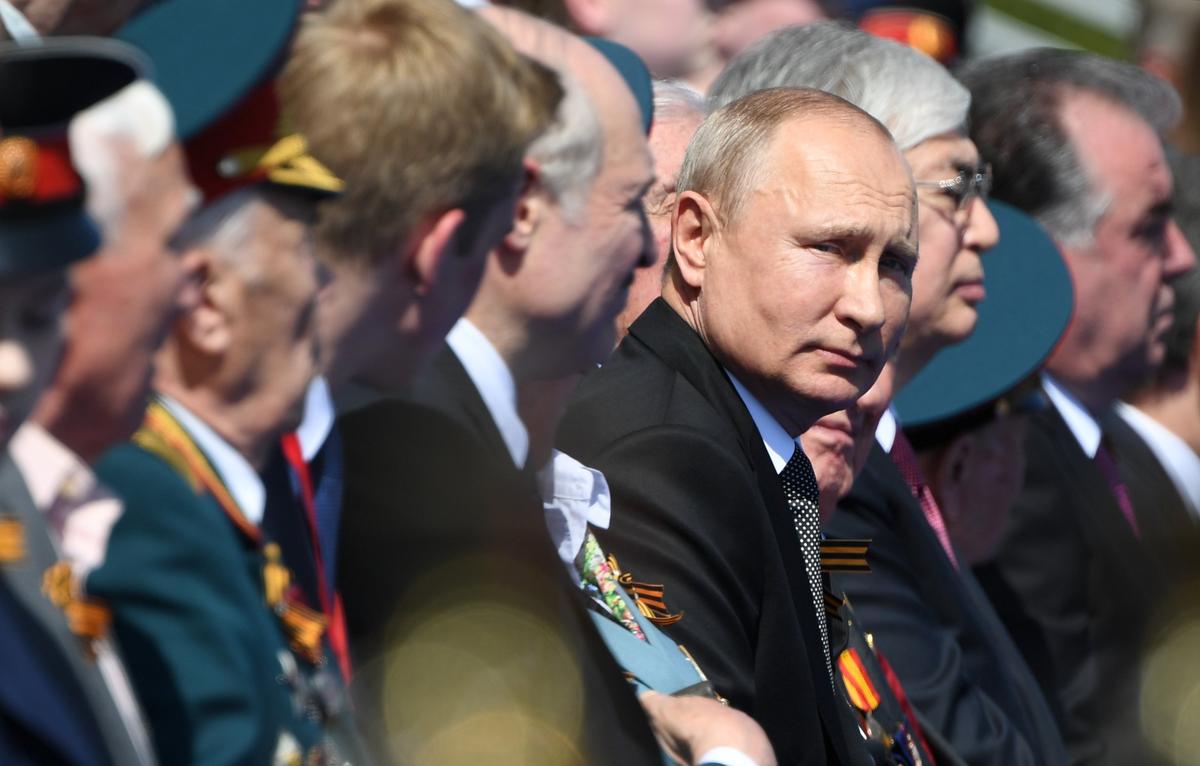
Putin attends Victory Day on the 75th anniversary of the Nazi defeat, 24 June 2020. Photo: EPA-EFE / SERGEY PYATAKOV
In 2021, the scope of Putin’s ambitions expanded, however. That year he declared that “people of all nationalities and faiths fought for every inch of their native land”, by which, he meant the Soviet Union, as bizarre as it was to associate the USSR and the many religious groups its leadership persecuted. As part of the homeland, Putin listed “the shores of the Baltic”, much of which were only occupied by the Soviets following the secret Molotov-Ribbentrop pact, concluded with Nazi Germany, as well as Ukraine.
If the Soviet Union is Russia, and the Russian people are heirs to the Soviet wartime generation that fought for its homeland, then it’s not difficult to deduce which lands Putin regards as rightfully being his for the taking. During the same speech, he affirmed the Russian-Soviet link when speaking about the holiday: “It is ours by right as heirs of the victorious generation, the generation we honor and are proud of.”
In hindsight, the entire 2021 speech sounded like an announcement of intent, a large part of which Putin dedicated to intimidating the Russian public with the spectre of the “Nazi” threat. As the speech reached its climax, he vowed that Russia would “firmly defend its national interests and ensure the security of its people”. Given that spring 2021 saw Russian military exercises take place close to the Ukrainian border, it was safe to assume that such an announcement was made very intentionally.
Masks off (2022-2024)
Putin’s Victory Day rhetoric underwent radical changes following the invasion of Ukraine in early 2022. On 9 May that year, the most notable change was the blatant manner in which Putin named the terrorists, neo-Nazis or historical revisionists he had previously only ever alluded to in his speeches in abstract terms. These include the US, NATO and the “collective West”, whom he accused of arming neo-Nazis in Ukraine, as well as preparing to invade Russia themselves with the aim of destroying the country’s “traditional values”.
Whereas politics were previously just a part of the address, taking up a notable amount of space along with other prominent themes, since 2022, politics were the speech.
At the same time, Putin continued to maintain that Russia was the innocent party in its unprovoked invasion of a neighbouring state. “Russia called on the West to engage in honest dialogue, to seek reasonable, compromise solutions, to take into account each other’s interests — all in vain. NATO countries did not want to hear us,” he thundered, arguing simply that as Ukraine and its allies intended to launch an attack, Russia had simply carried out a preemptive strike.
Whereas politics were previously just a part of the address, taking up a notable amount of space along with other prominent themes, since 2022, politics were the speech. Though matters of history and identity do get some attention, the invasion of Ukraine and the endless fixation on Russia’s foreign policy are now the issues that predominate.
In his speeches during these years, Putin repeatedly accuses Russia’s enemies of using international terrorists against the country, of attempting to sow ethnic and religious discord, and gathering “neo-Nazi scum from all over the world” to invade the country. During this period, perceived historical revisionism is continually used as a way to rebuke the West, as Putin demonstrated in 2023, when he accused it of “demolishing memorials to those who truly fought against Nazism, while idolising traitors and Nazi collaborators”.
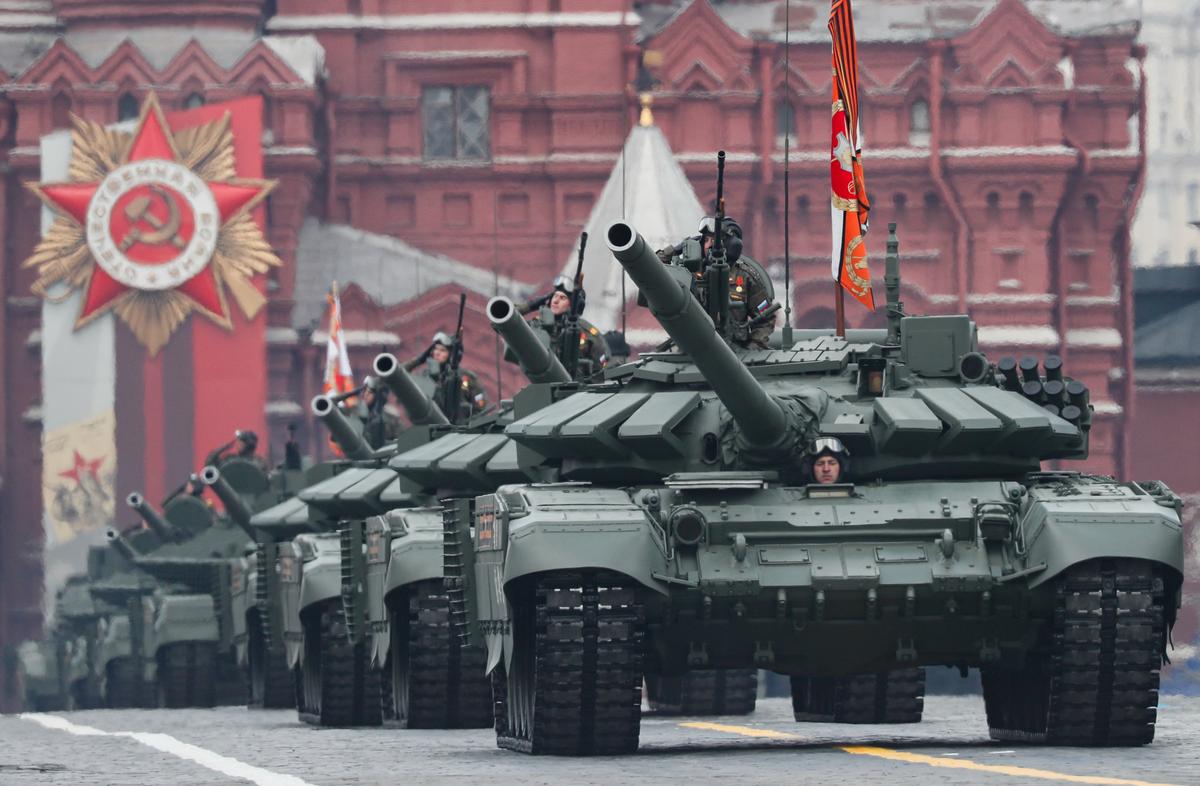
Russian tanks roll through Moscow’s Red Square, 9 May 2022. Photo: EPA-EFE / YURI KOCHETKOV
He affirms that support for the war is a part of the Russian identity, linking the wartime years of the past to the wartime years of today, and soldiers of the past to the soldiers of the present. “Today you are defending what your fathers, grandfathers and great-grandfathers fought for.” Putin addressed the soldiers, implying that the war is defensive in nature. In his worldview, Russians are the USSR and the enemy is of course the Third Reich.
Thinking this way, Putin accused the “Western globalist elites” of promoting “aggressive nationalism” in 2023 in spite of the obvious incompatibility of the two ideas. That same year, he joyfully declared that there is an “inevitable shift towards a more just multipolar world”, publicly acknowledging his belief in Alexander Dugin’s ideology.
The recent Victory Day speeches confirm Putin’s newfound love for ancient history as a source of meaning and legitimacy that the world saw during the notorious Tucker Carlson interview. 2023 sees Putin invoke a wide range of historical figures from Yuri Dolgorukiy, a 12th century ruler of the Kievan Rus, to Mikhail Kutuzov, the famous Russian general of the Napoleonic era. Before the invasion, Putin never ventured beyond the 1930’s during Victory Day speeches, staying firmly within the boundaries of the Great Patriotic War and giving occasional mentions to post-war years.
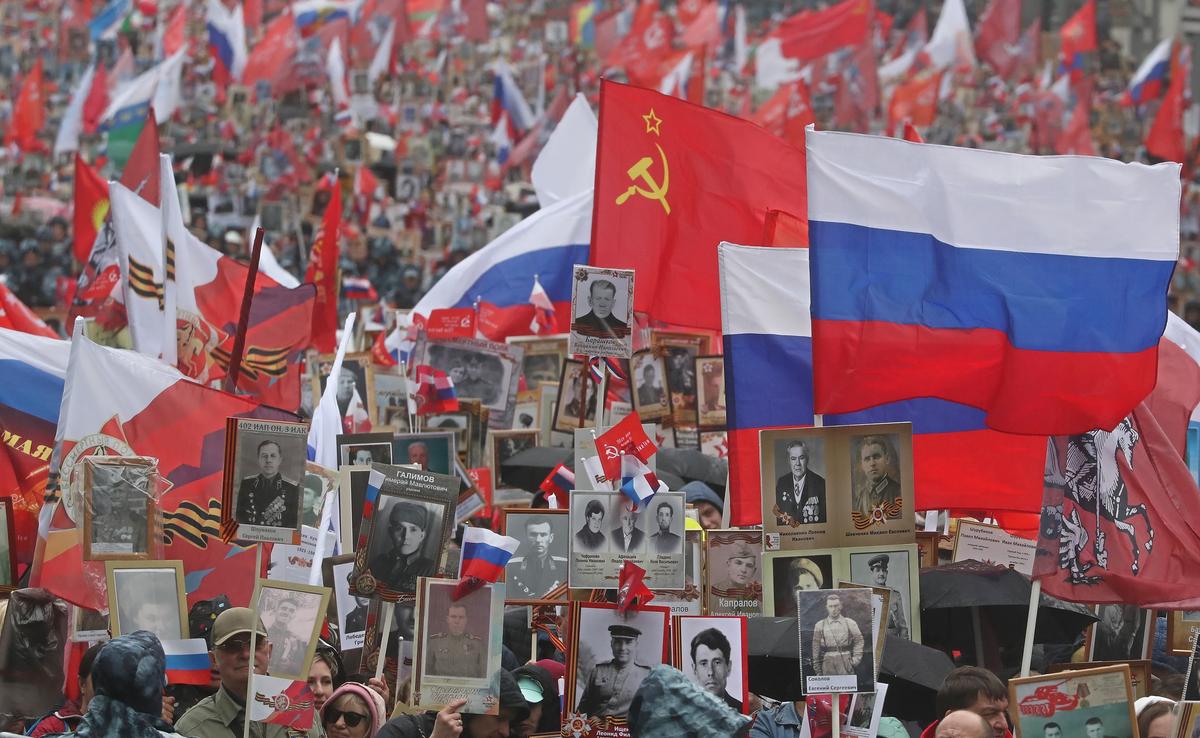
People hold up portraits of their relatives who fought World War II as part of Victory Day celebrations in Moscow’s Red Square, 9 May 2022. Photo: EPA-EFE / MAXIM SHIPENKOV
Putin paid homage to Dugin yet again in 2024, when he accused “Western elites” of trying to “contain sovereign, independent centres of global development” through “inciting regional conflicts, religious and ethnic enmity” and hurled accusations of wanting to “distort the truth about World War II” at them. Because according to him, this truth was a nuisance for “those who are accustomed to basing their essentially colonial policies on hypocrisy and lies”.
Overall, Victory Day speeches given since the Russian invasion of Ukraine mark the final stage of the holiday’s exploitation as a political tool for the Putin regime. After initially being deployed as a means of furnishing the post-Soviet Russian population with a workable national identity, it was repurposed as a national myth to consolidate pro-war Russian public opinion.
This process spanned several decades, yet given the effectiveness of such messaging, it appears to have been well worth the effort from the Kremlin’s point of view, as Putin appeared to confirm in 2024, when he announced in his speech that it was time to “bow our heads to the veterans of the Great Patriotic War who have left us”, immediately after which going on to praise the modern Russian soldiers he describes as having fallen “in the fight against neo-Nazism, in the righteous fight for Russia.”
Join us in rebuilding Novaya Gazeta Europe
The Russian government has banned independent media. We were forced to leave our country in order to keep doing our job, telling our readers about what is going on Russia, Ukraine and Europe.
We will continue fighting against warfare and dictatorship. We believe that freedom of speech is the most efficient antidote against tyranny. Support us financially to help us fight for peace and freedom.
By clicking the Support button, you agree to the processing of your personal data.
To cancel a regular donation, please write to [email protected]
